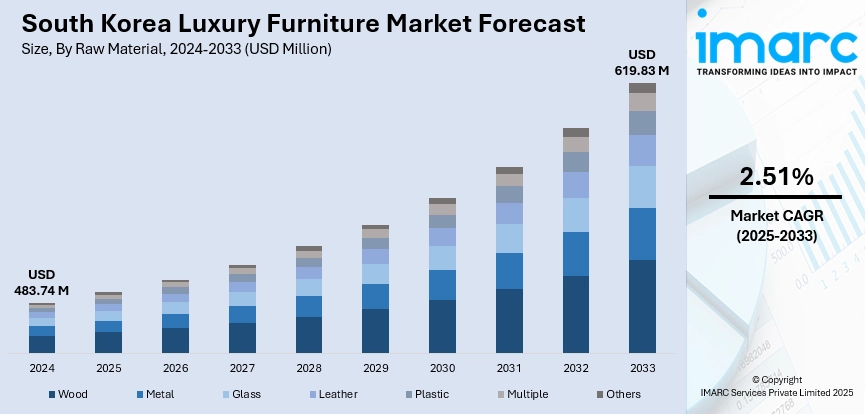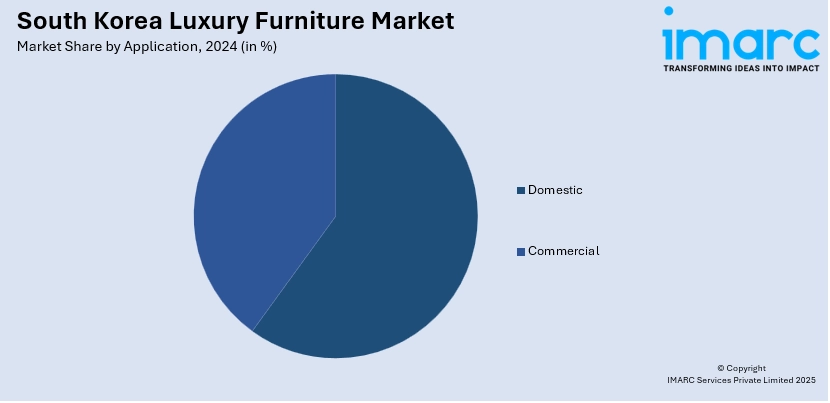
South Korea Luxury Furniture Market Size, Share, Trends and Forecast by Raw Material, Application, Distribution Channel, Design, and Region, 2025-2033
South Korea Luxury Furniture Market Overview:
The South Korea luxury furniture market size reached USD 483.74 Million in 2024. Looking forward, the market is projected to reach USD 619.83 Million by 2033, exhibiting a growth rate (CAGR) of 2.51% during 2025-2033. The market is driven by growing wealth and aspirational home design trends among urban consumers seeking status-defining furnishings. Design innovation and brand positioning, emphasizing craftsmanship, sustainability, and global aesthetics, are enhancing product desirability. Advanced omni-channel retail strategies, including immersive showrooms and personalized service ecosystems, are further augmenting the South Korea luxury furniture market share.
|
Report Attribute
|
Key Statistics
|
|---|---|
|
Base Year
|
2024 |
|
Forecast Years
|
2025-2033
|
|
Historical Years
|
2019-2024
|
| Market Size in 2024 | USD 483.74 Million |
| Market Forecast in 2033 | USD 619.83 Million |
| Market Growth Rate 2025-2033 | 2.51% |
South Korea Luxury Furniture Market Trends:
Rising Affluent Demographic and Home Aspirational Trends
South Korea has witnessed a rising cohort of high-net-worth individuals who view luxury furniture as a symbol of status, taste, and cultural sophistication. Urban homeowners in Seoul, Busan, and Jeju are investing in premium pieces, such as handcrafted solid wood tables, designer sofas, and bespoke storage systems, to elevate living spaces. Many buyers prioritize curated narratives: heritage-inspired craftsmanship, limited-edition collections, and internationally renowned designers. The trend extends to renovation projects and luxury apartments, where interior designers and architects incorporate statement furnishings tailored to discerning clients’ lifestyles. Increasingly, homeowners seek tailored consultations, material sourcing transparency, and post-sale services such as installation and maintenance. These expectations are encouraging retailers and brand houses to offer exclusive showrooms, private viewings, and VIP customer programs. South Korea luxury furniture market growth is being driven by these evolving consumer behaviors that marry wealth accumulation with experiential product value, marked by creativity, service, and connoisseurship.

To get more information on this market, Request Sample
Branding, Design Innovation, and Global Market Influence
Prestige brands, both local and international, are shaping consumer preferences in the premium furnishing segment. European and Scandinavian names bring design-led minimalism, while traditional Korean-inspired brands emphasize natural materials and artisanal detailing. Collaborative capsule collections combining local craftsmanship and global design expertise have become especially sought-after. Designers and manufacturers are exploring eco-conscious materials, digitally enhanced finishes, and modular systems that adapt to compact urban homes. Marketing narratives now foreground traceability, sustainability, and craftsmanship, presenting furniture as lifestyle investments rather than disposable commodities. Exposure to design fairs, virtual reality showroom tours, and influencer campaigns help buyers navigate quality and style nuances. Domestic manufacturers are also leveraging maker communities and design incubators to promote a new wave of homegrown luxury. These brand dynamics and design-forward strategies are instrumental in elevating consumer expectations and stimulating product premiumization.
Omni‑Channel Retail Strategy and Experiential Shopping
The luxury furniture market in South Korea is evolving through sophisticated omni-channel retail models. Flagship showrooms in upscale districts offer immersive experiences—such as material touch-and-feel zones, curated room sets, and augmented-reality visualization tools that enable real-time configuration and prototyping. Online platforms complement in-store visits with personalized virtual consultations, streamlined ordering, and white-glove delivery options. AR-enabled apps allow customers to preview furniture within their own rooms, reducing decision friction. Retailers also offer design advisory services, trade-in or bespoke customization, and maintenance warranties—creating long-term client relationships. International brands are launching pop-ups and concept stores in partnership with local galleries or cultural venues. Post-sale services, including installation, repair services, and reupholstery, are now integral to the value proposition. This integration of digital convenience with tactile luxury has reshaped the purchasing journey, enabling premium brands to scale while maintaining exclusivity, thus supporting sustained market expansion and consumer loyalty.
South Korea Luxury Furniture Market Segmentation:
IMARC Group provides an analysis of the key trends in each segment of the market, along with forecasts at the country and regional levels for 2025-2033. Our report has categorized the market based on raw material, application, distribution channel, and design.
Raw Material Insights:
- Wood
- Metal
- Glass
- Leather
- Plastic
- Multiple
- Others
The report has provided a detailed breakup and analysis of the market based on the raw material. This includes wood, metal, glass, leather, plastic, multiple, and others.
Application Insights:

- Domestic
- Living Room and Bedroom
- Kitchen
- Bathroom
- Outdoor
- Lighting
- Commercial
- Office
- Hospitality
- Others
The report has provided a detailed breakup and analysis of the market based on the application. This includes domestic (living room and bedroom, kitchen, bathroom, outdoor, and lighting) and commercial (office, hospitality, and others).
Distribution Channel Insights:
- Conventional Furniture Stores
- Specialty Stores
- Online Retailers
- Others
The report has provided a detailed breakup and analysis of the market based on the distribution channel. This includes conventional furniture stores, specialty stores, online retailers, and others.
Design Insights:
- Modern
- Contemporary
The report has provided a detailed breakup and analysis of the market based on the design. This includes modern and contemporary.
Regional Insights:
- Seoul Capital Area
- Yeongnam (Southeastern Region)
- Honam (Southwestern Region)
- Hoseo (Central Region)
- Others
The report has also provided a comprehensive analysis of all major regional markets. This includes Seoul Capital Area, Yeongnam (Southeastern Region), Honam (Southwestern Region), Hoseo (Central Region), and others.
Competitive Landscape:
The market research report has also provided a comprehensive analysis of the competitive landscape. Competitive analysis such as market structure, key player positioning, top winning strategies, competitive dashboard, and company evaluation quadrant has been covered in the report. Also, detailed profiles of all major companies have been provided.
South Korea Luxury Furniture Market News:
- On April 14, 2025, Shinsegae Department Store launched The Heritage, a luxury boutique and cultural space in central Seoul, by repurposing a 90-year-old heritage site into a five-story high-end retail complex. The location features flagship outlets from global brands including Chanel, Lalique, Baccarat, and Bang & Olufsen, with over 70 pieces of designer furniture and artwork.
South Korea Luxury Furniture Market Report Coverage:
| Report Features | Details |
|---|---|
| Base Year of the Analysis | 2024 |
| Historical Period | 2019-2024 |
| Forecast Period | 2025-2033 |
| Units | Million USD |
| Scope of the Report |
Exploration of Historical Trends and Market Outlook, Industry Catalysts and Challenges, Segment-Wise Historical and Future Market Assessment:
|
| Raw Materials Covered | Wood, Metal, Glass, Leather, Plastic, Multiple, Others |
| Applications Covered |
|
| Distribution Channels Covered | Conventional Furniture Stores, Specialty Stores, Online Retailers, Others |
| Designs Covered | Modern, Contemporary |
| Regions Covered | Seoul Capital Area, Yeongnam (Southeastern Region), Honam (Southwestern Region), Hoseo (Central Region), Others |
| Customization Scope | 10% Free Customization |
| Post-Sale Analyst Support | 10-12 Weeks |
| Delivery Format | PDF and Excel through Email (We can also provide the editable version of the report in PPT/Word format on special request) |
Key Questions Answered in This Report:
- How has the South Korea luxury furniture market performed so far and how will it perform in the coming years?
- What is the breakup of the South Korea luxury furniture market on the basis of raw material?
- What is the breakup of the South Korea luxury furniture market on the basis of application?
- What is the breakup of the South Korea luxury furniture market on the basis of distribution channel?
- What is the breakup of the South Korea luxury furniture market on the basis of design?
- What is the breakup of the South Korea luxury furniture market on the basis of region?
- What are the various stages in the value chain of the South Korea luxury furniture market?
- What are the key driving factors and challenges in the South Korea luxury furniture market?
- What is the structure of the South Korea luxury furniture market and who are the key players?
- What is the degree of competition in the South Korea luxury furniture market?
Key Benefits for Stakeholders:
- IMARC’s industry report offers a comprehensive quantitative analysis of various market segments, historical and current market trends, market forecasts, and dynamics of the South Korea luxury furniture market from 2019-2033.
- The research report provides the latest information on the market drivers, challenges, and opportunities in the South Korea luxury furniture market.
- Porter's five forces analysis assist stakeholders in assessing the impact of new entrants, competitive rivalry, supplier power, buyer power, and the threat of substitution. It helps stakeholders to analyze the level of competition within the South Korea luxury furniture industry and its attractiveness.
- Competitive landscape allows stakeholders to understand their competitive environment and provides an insight into the current positions of key players in the market.
Need more help?
- Speak to our experienced analysts for insights on the current market scenarios.
- Include additional segments and countries to customize the report as per your requirement.
- Gain an unparalleled competitive advantage in your domain by understanding how to utilize the report and positively impacting your operations and revenue.
- For further assistance, please connect with our analysts.
 Request Customization
Request Customization
 Speak to an Analyst
Speak to an Analyst
 Request Brochure
Request Brochure
 Inquire Before Buying
Inquire Before Buying




.webp)




.webp)












